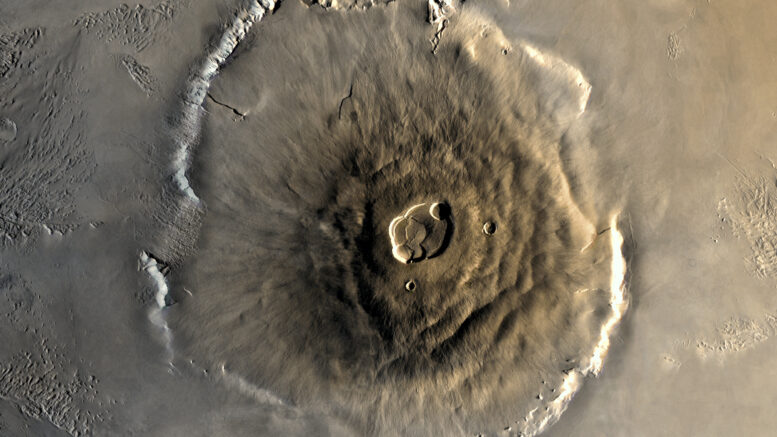One of the most iconic and most well known features on the entire Martian landscape is Olympus Mons. There are many interesting features on Mars, but Olympus Mons definitely takes the cake as the biggest volcano!
Olympus Mons is a technically a shield volcano, with a diameter of 374 miles or 624 km, which would make it approximately the same size as the US state of Arizona. It reaches 16 miles or 25 km in height, and is rimmed by a 4 mile or 6 km high scarp. There is also a caldera that stretches 50 miles or 80 km wide that is located at the summit of Olympus Mons. [1] To put its diameter in size, it would be larger than any state in the Pacific Northwest alone. For a sense of how large Olympus Mons is, it is 100 times larger than the largest Earth volcano, which is Mauna Kea in Hawaii.[1] Mauna Kea is the probably most familiar shield volcano in the world, as there aren’t any oof this kind in the Pacific Northwest.
According to Oregon State, “Shield volcanoes are almost exclusively basalt, a type of lava that is very fluid when erupted. For this reason these volcanoes are not steep (you can’t pile up a fluid that easily runs downhill). Eruptions at shield volcanoes are only explosive if water somehow gets into the vent, otherwise they are characterized by low-explosivity fountaining that forms cinder cones and spatter cones at the vent, however, 90% of the volcano is lava rather than pyroclastic material.”[2]
The reason that Olympus Mons is so large is that on Mars, there are no tectonic plates. Tectonic plates on Earth are the plates that the continents and land sit on, which will move over time. As these tectonic plates move into each other, volcanos on Earth get created. As Mars lacks these features, volcanos on the planet can grow to monstrous sizes, roughly 10 to 100 times the sizes of those on Earth. Therefore, it makes sense that the lava would just keep piling up into a very large mountain.
The last time that Olympus Mons erupted was 25 million years ago according to some estimates. During these eruptions, “the lava flows on the Martian surface are observed to be much longer, probably a result of higher eruption rates and lower surface gravity.”[1]
Olympus Mons is an unlikely landing location for automated space probes in the near future. The high elevations preclude parachute-assisted landings because the atmosphere is insufficiently dense to slow the spacecraft down. Moreover, Olympus Mons stands in one of the dustiest regions of Mars. A mantle of fine dust obscures the underlying bedrock, possibly making rock samples hard to come by and likely posing a significant obstacle for rovers. Moreover, it is easily visible from space due to its massive size.
Sources And Further Reading
To read more about different planetary bodies and planetary features like this, check out these articles.
[1] = https://mars.nasa.gov/gallery/atlas/olympus-mons.html
[2] = http://volcano.oregonstate.edu/shield-volcanoes

Be the first to comment on "Olympus Mons"